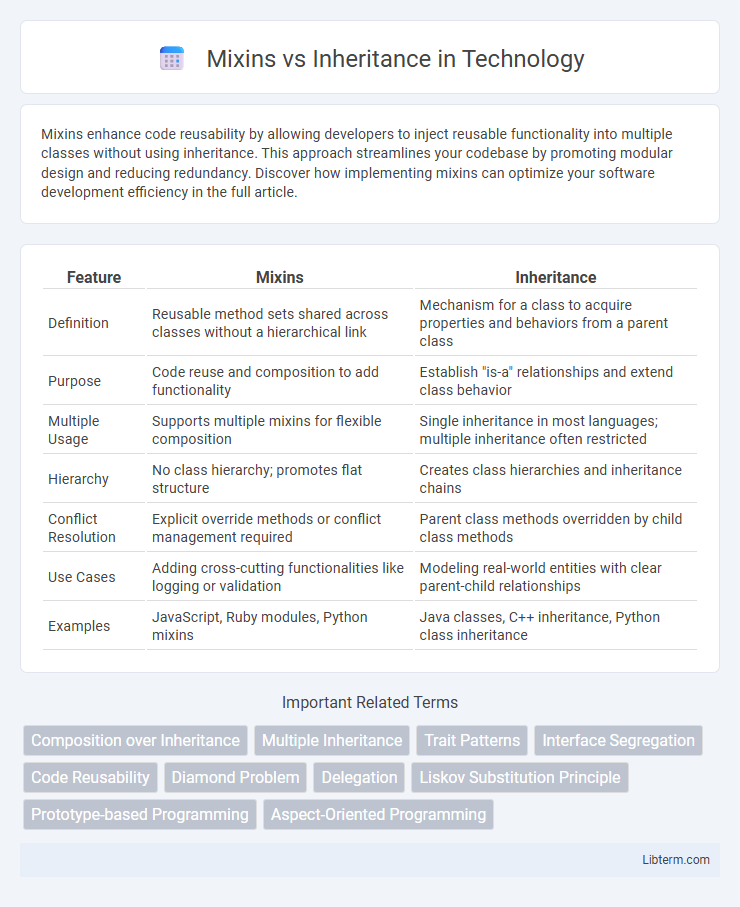Mixins enhance code reusability by allowing developers to inject reusable functionality into multiple classes without using inheritance. This approach streamlines your codebase by promoting modular design and reducing redundancy. Discover how implementing mixins can optimize your software development efficiency in the full article.
Table of Comparison
| Feature | Mixins | Inheritance |
|---|---|---|
| Definition | Reusable method sets shared across classes without a hierarchical link | Mechanism for a class to acquire properties and behaviors from a parent class |
| Purpose | Code reuse and composition to add functionality | Establish "is-a" relationships and extend class behavior |
| Multiple Usage | Supports multiple mixins for flexible composition | Single inheritance in most languages; multiple inheritance often restricted |
| Hierarchy | No class hierarchy; promotes flat structure | Creates class hierarchies and inheritance chains |
| Conflict Resolution | Explicit override methods or conflict management required | Parent class methods overridden by child class methods |
| Use Cases | Adding cross-cutting functionalities like logging or validation | Modeling real-world entities with clear parent-child relationships |
| Examples | JavaScript, Ruby modules, Python mixins | Java classes, C++ inheritance, Python class inheritance |
Introduction to Object-Oriented Programming Paradigms
Inheritance in object-oriented programming enables classes to derive properties and methods from parent classes, promoting code reuse and hierarchical relationships. Mixins provide a flexible alternative by allowing classes to incorporate reusable behaviors without establishing strict parent-child relationships. This paradigm supports composability and avoids complexities associated with deep inheritance chains, enhancing modularity and maintainability.
Defining Mixins: Concept and Usage
Mixins are reusable classes designed to add specific functionality to other classes without using traditional inheritance hierarchies, promoting composition over inheritance. They enable multiple inheritance in a modular way by allowing a class to incorporate methods and properties from multiple sources, enhancing code reuse and reducing redundancy. Mixins are commonly used in languages like Python and JavaScript to extend behavior while maintaining flexible and maintainable code architecture.
Understanding Inheritance: Core Principles
Inheritance is a fundamental concept in object-oriented programming that allows a class to inherit properties and methods from a parent class, promoting code reuse and hierarchical relationships. It establishes an "is-a" relationship, where the child class extends or specializes the behavior of the superclass, enabling polymorphism and method overriding. Core principles include encapsulation of common features in base classes and the ability to create complex systems through multi-level inheritance chains.
Key Differences Between Mixins and Inheritance
Mixins provide a way to compose classes by adding reusable methods without forming a parent-child relationship, whereas inheritance establishes a hierarchy with a subclass inheriting properties and behaviors from a superclass. Mixins promote horizontal code reuse by enabling multiple sources of functionality to be combined, while inheritance enables vertical reuse with a single lineage and overrides extending base class behavior. Mixins avoid issues like the diamond problem in multiple inheritance, offering more flexible and modular designs compared to the rigid structure imposed by traditional inheritance.
Advantages of Using Mixins
Mixins offer greater flexibility by allowing multiple reusable behaviors to be composed without the rigid hierarchy imposed by inheritance. They reduce code duplication and enhance maintainability by enabling modular additions of functionality across diverse classes. Mixins facilitate easier testing and evolve independently, promoting better separation of concerns in object-oriented design.
Benefits and Drawbacks of Inheritance
Inheritance enables code reuse by allowing classes to derive properties and methods from parent classes, promoting a clear hierarchical structure. It simplifies the extension of existing functionality but can lead to tight coupling and reduced flexibility, making maintenance and scalability challenging in complex systems. Over-reliance on inheritance may cause fragile base class problems and limit the ability to compose behaviors dynamically compared to mixins.
Common Use Cases for Mixins
Mixins are commonly used in object-oriented programming to share reusable functionalities across multiple classes without using inheritance, allowing for greater flexibility and modular code design. They are ideal for cases where different classes require similar behaviors, such as logging, event handling, or input validation, without forming a rigid class hierarchy. Mixins promote composition over inheritance, reducing complexity and enhancing code maintainability in large-scale software projects.
When to Prefer Inheritance Over Mixins
Inheritance is preferred over mixins when a clear hierarchical relationship exists and shared behavior needs to be extended or specialized within a class structure. It simplifies maintenance by centralizing common methods and properties in a base class, ensuring consistency and reducing code duplication. Large-scale applications with well-defined domain models benefit from inheritance to establish strong is-a relationships and predictable object hierarchies.
Real-World Examples: Mixins vs Inheritance
Mixins are ideal for sharing reusable behavior across classes, such as adding logging or serialization capabilities to different objects without altering their primary inheritance structure. In contrast, inheritance is suited for establishing a clear hierarchical relationship, like modeling animals where a Dog class inherits from an Animal class to maintain shared traits and behaviors. Real-world examples include using mixins in UI frameworks to apply draggable or resizable features to multiple components, whereas inheritance is used in software designs like employee management systems where a Manager class extends an Employee class to incorporate role-specific attributes.
Choosing the Right Approach for Your Project
Choosing between mixins and inheritance depends on the complexity and scalability needs of your project. Mixins offer flexible code reuse by allowing multiple functionalities to be combined without the constraints of a strict class hierarchy, making them ideal for traits or behavior sharing. Inheritance, while providing a clear hierarchical structure, can lead to rigid designs and tight coupling, so it's best suited for scenarios with well-defined "is-a" relationships and where extending base classes simplifies maintenance.
Mixins Infographic

 libterm.com
libterm.com